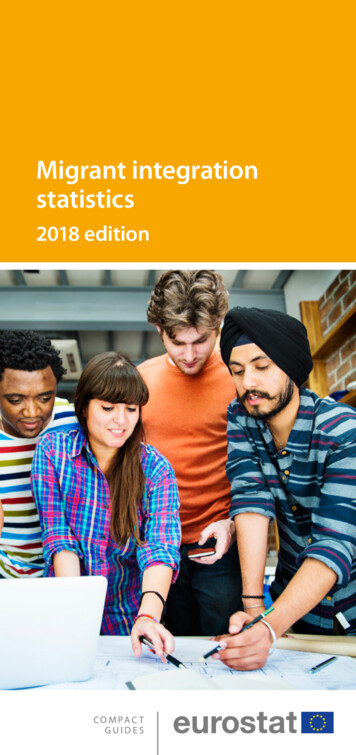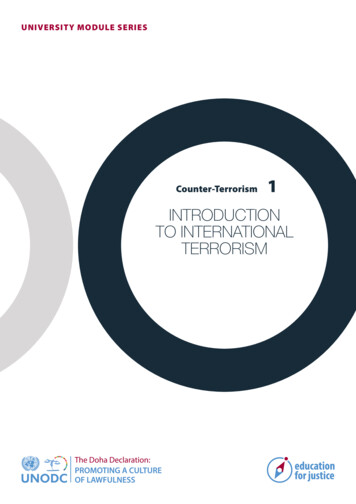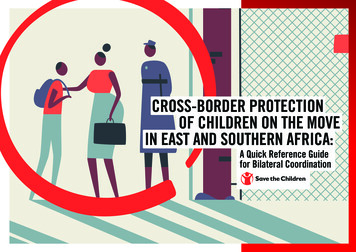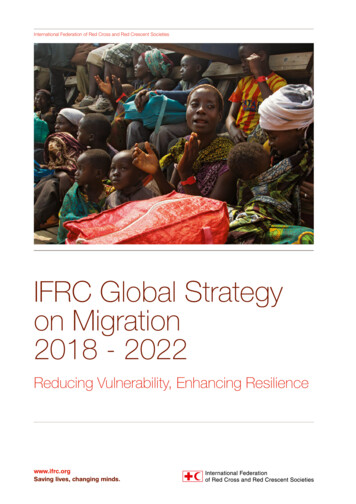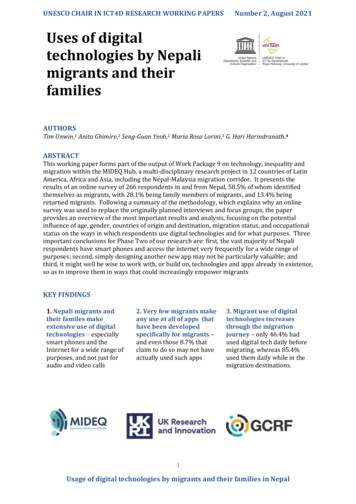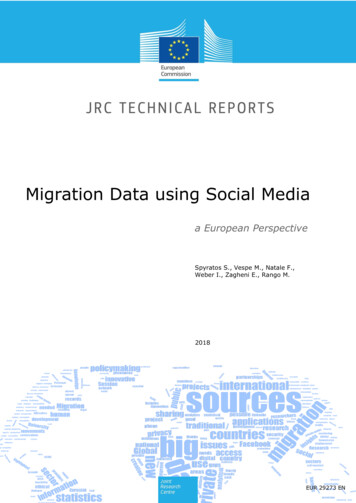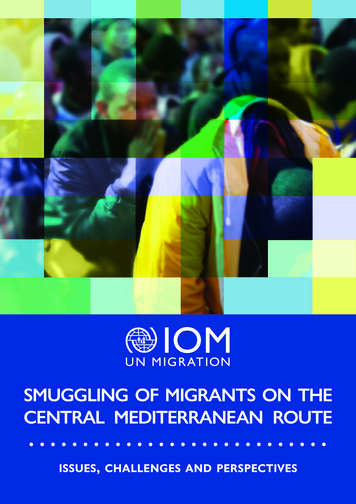
Transcription
SMUGGLING OF MIGRANTS ON THECENTRAL MEDITERRANEAN ROUTEissues, challenges and perspectives
IOM/2014
The opinions expressed in the report are those of the authors and do not necessarily reflect the views of theInternational Organization for Migration (IOM). The designations employed and the presentation of materialthroughout the report do not imply expression of any opinion whatsoever on the part of IOM concerning thelegal status of any country, territory, city or area, or of its authorities, or concerning its frontiers or boundaries.IOM is committed to the principle that humane and orderly migration benefits migrants and society. As anintergovernmental organization, IOM acts with its partners in the international community to: assist in meeting theoperational challenges of migration; advance understanding of migration issues; encourage social and economicdevelopment through migration; and uphold the human dignity and well-being of migrantsInternational Organization for Migration17 route des MorillonsP.O. Box 171211 Geneva 19SwitzerlandTel.: 41 22 717 9111Fax : 41 22 798 6150Email : hq@iom.intWebsite : www.iom.intPublisher : Organisation internationale pour les migrationsBadalabougou Gamal A Nasser Street, Door 756B.P.288Bamako, MaliTel. : 223 20 22 76 97 223 20 22 76 98Email : iombamako@iom.intWebsite : mali.iom.int 2021 International Organization for Migration (IOM)Some rights reserved. This work is made available under the Creative Commons Attribution-NonCommercialNoDerivs 3.0IGO License (CC BY-NC-ND 3.0 IGO).*For further specifications please see the Copyright and Terms of Use.This publication should not be used, published or redistributed for purposes primarily intended for or directed towardscommercial advantage or monetary compensation, with the exception of educational purposes e.g. to be included in textbooks.P3
Table of ContentsExecutive Summary.7Introduction.16Methodology.181. Legal and Policy Framework in the Fight Against Smuggling of Migrants.211. The Legal Framework for Combating the Smuggling of Migrants at the International Level.211.1. The Protocol Against the Smuggling of Migrants.221.2. The Protection of Smuggled Migrants.222. The Fight Against the Smuggling of Migrants at the Regional Level.242.1. The Revised Migration Policy Framework for Africa.242.2. The ECOWAS Common Approach on Migration.252.3. The Africa-Europe Partnership.253. National Legal Frameworks.273.1. Niger.273.2. Mali.293.3. Libya.303.4. Algeria.322. Profiles and Characteristics of Migrants using the Central Mediterranean Route.352.1. Origin of Migrants Using the Central Mediterranean Route.352.2. Motivations of West African Migrants.373. Profiles of Actors Involved in Migrant Smuggling.393.1. Typology of the Actors Involved in Migrant Smuggling.393.1.1. Organizers and Coordinators of Migrant Smuggling.393.1.2. Transporters (Drivers) and Guides.403.1.3. Recruiters.423.1.4. Other “Service Providers”.423.1.5. The Role of the Authorities and the Corruption.433.2. Level of Organization of Traffickers’ Networks.443.3. Links Between Smuggling of Migrants and Other Forms of Crime.464. Overview of the Main Migration Routes and Traffickers’ Modus Operandi.524.1. Movements Within ECOWAS.524.2. The Route Between Niger and Libya.534.3. The Road Between Niger and Algeria.564.4. The Road Between Mali and Algeria.574.5. Destination Europe: Crossing Libya and Algeria.594.5.2. Transit in Algeria.594.5.1. Crossing Libya.61P44.6. The crossing of the Mediterranean Sea.63
5. The Economic Dimension of Migrant Smuggling.675.1. Methods Used to Fund the Smuggling of Migrants.675.1.1. The “Package” Option.685.1.2. Step-by-step Payment.685.1.3. Payment on Credit.695.2. Revenues Generated by the Smuggling of Migrants.705.2.1. Sums Generated by the Smuggling of Migrants along the Central Mediterranean Route.705.2.2. A Broader Economy Around Migration: The Example of Agdez.726. Main Risks for Smuggled Migrants.776.1. Crossing the Desert.776.2. Crossing Borders.786.3. The dangers of crossing the Mediterranean Sea.796.4. Lack of Legal Status as a Source of Vulnerability in Algeria.806.5. Detention and Exploitation in Libya.816.6. From Migrant Smuggling to Trafficking in Persons.827. Strengthening the Fight Against the Smuggling of Migrants on the Central Mediterranean Route.847.1. Ensuring National Leadership in the Fight Against Migrant Smuggling.847.2. Criminalizing the Smuggling of Migrants .857.3. Detection and Arrest of Traffickers.867.4. Strengthening Border Control.877.5. Strengthening Inter-Institutional Coordination.907.6. Facilitating Cooperation Between Countries.927.7. Training and Technical Co-operation.947.8. Collecting, Managing, Analysing and Sharing Information.957.9. Ensuring the Protection of Trafficked Persons.977.10. Addressing the Root Causes of Irregular Migration.98Conclusion.100Bibliography.102P5
List of AcronymsP6ANLTP/TIMNational Agency to Fight Trafficking in Persons and Smuggling of Migrants - Agencenationale de lutte contre la traite des personnes et le trafic illicite de migrants(Niger).BRTMTEHMigrant smuggling and human trafficking squad - Brigade de répression du trafic demigrants et de la traite d’êtres humains (Mali).CNCLTP/TIMNational Commission for the Coordination of the Fight against Trafficking inPersons and Smuggling of Migrants - Commission nationale de coordination de lalutte contre la traite des personnes et le trafic illicite des migrants (Niger).DTMDisplacement Tracking MatrixECOWASEconomic Community of West African StatesEUEuropean UnionEUBAMLibyaEUCAPEuropean Union Capacity Building MissionGATIAImghad Tuareg Self-Defense Group and AlliesICMPDInternational Centre for Migration Policy DevelopmentILOInternational Labour OrganizationIOMInternational Organization for MigrationISILIslamic State of Iraq and the LevantJITJoint Investigation TeamMLNANational Movement for the Liberation of AzawadMMCMixed Migration CentreMSPCMinistry of Security and Civil Protection (Mali) Ministère de la sécurité et de laprotection civile (Mali).OHCHROffice of the United Nations High Commissioner for Human RightsPONAMNational migration policy (Mali) - Politique nationale de migration (Mali)SIPAOPolice information system in West Africa - Système d’information policière enAfrique de l’OuestAUAfrican UnionUNFPAUnited Nations Population FundUNHCRUnited Nations High Commissioner for RefugeesUNODCUnited Nations Office on Drugs and CrimeUNSMILUnited Nations Support Mission in LibyaEuropean Union Border Assistance Mission in Libya
Executive SummaryThe Central Mediterranean route, which covers movements from North Africa to Italy via the Mediterranean Sea,is the most common route used by migrants to travel irregularly to Europe. It is estimated that between 2015and 2019, almost 657,000 migrants arrived in Italy by this route. After a peak in migrant arrivals via the CentralMediterranean route in 2016, movements have dropped considerably due to measures put in place in severalcountries in the region, to tackle irregular immigration and smuggling of migrants.Before reaching the Mediterranean Coast, the vast majority of the people have used the services of smugglers totransit from sub-Saharan Africa to Algeria or Libya, and then to organize the crossing of the Mediterranean. Othersuse the services of traffickers directly from their country of origin, resulting in everything having been prearrangedup until their arrival in a European country. Thus, it is believed that the smuggling of migrants to Europe has becomean extremely lucrative activity worth several hundred million dollars each year. Several recent studies highlight theincreasing professionalization of trafficking networks along the Central Mediterranean route, but also the risks ofviolence linked to competition between different groups, as well as the links with other forms of transnationalorganized crime, such as drugs or arms trafficking, and even links with terrorist groups.At the same time, the fight against the smuggling of migrants along the Central Mediterranean route has becomea priority for many States, be it to tackle transnational organized crime, prevent irregular migration or preventfurther tragedies. Initiatives aimed at strengthening the capacities of States along the Central Mediterranean routeto tackle the smuggling of migrants have multiplied in recent years, leading to a clear decrease in migratory flowsthrough this corridor.Drawn up between February and September 2020 within the framework of the MIRAC project1 implementedby the IOM-Mali, this report proposes an inventory of the issue of the smuggling of migrants along the CentralMediterranean route, with particular reference to movements from West Africa and through Mali and Niger toAlgeria and/or Libya and then to Europe. The report is primarily directed at the national authorities of these fourcountries, which are particularly affected by the smuggling of migrants.The research aims to shed light on a number of important questions related to the smuggling of migrants fromWest Africa: where do migrants come from and what are their motivations? How are the movements from WestAfrica to North Africa and then to Europe organized? Who are the actors who facilitate these journeys? Howare they organized? What is their modus operandi? What are the economic stakes involved in the smuggling ofmigrants? And what are the risks to which migrants are exposed?Finally, the report examines some initiatives to support the States concerned in their fight against the smuggling of migrants.1Migration Resource Allocation Committee (MIRAC)P7
Legal and policy framework in the fight against smuggling of migrants Algeria, Libya, Mali and Niger have acceded to the United Nations Convention against Transnational OrganizedCrime and the Protocol against the Smuggling of Migrants by Land, Sea and Air. All four countries are also partiesto major human rights instruments, including the International Covenant on Economic, Social and Cultural Rightsand the International Covenant on Civil and Political Rights. Libya is the only country not party to the Conventionrelating to the Status of Refugees. Under the Protocol, States are required to recognize the smuggling of migrants as a criminal offence. Niger isto date the only one of the four countries to have adopted national legislation relating to the fight against thesmuggling of migrants. At the regional level, African States have adopted several declarations, including jointly with the European Union,reaffirming their commitment to combat the smuggling of migrants.Profiles and characteristics of migrants using the Central Mediterranean route Nationals from West African countries accounted for almost half of the migration flows along the Central Mediterraneanroute between 2015 and 2017. Their proportion then decreased to 22% and 15% in 2018 and 2019. More than a quarter of the migrants on the Central Mediterranean route are women and children. The proportionof children has been growing in recent years, reaching 20% of migration flows in 2019. Most migrants from West African countries migrate for economic reasons. The distinction between voluntaryand forced migration needs to be nuanced, however; it is recognized that most people migrate for a complex setof reasons and with varying degrees of coercion.Profiles of actors involved in migrant smuggling Migrants are likely to come into contact with a large number of people involved to varying degrees in thesmuggling of migrants. Generally speaking, a distinction is made between the organizers and coordinators ofmigrant smuggling; transporters and guides; recruiters; and various other “service providers” involved to varyingdegrees in this activity. Corruption facilitates the smuggling of migrants, including in countries along the Central Mediterranean route.The Convention against Transnational Organized Crime requires States Parties to combat both active corruption(promising, offering or giving an undue advantage to a public official in order that the official act or refrain from actingan act) and passive corruption (acceptance by a public official of an undue advantage to act or refrain from acting). There is a significant fragmentation in terms of the actors involved in the smuggling of migrants along the CentralMediterranean route; The market is not dominated by one group but rather by a plurality of actors with varyinglevels of coordination.P8
While traffickers are also involved in other types of trafficking such as tramadol or fuel trafficking, the link betweensmuggling of migrants and other more serious types of crime (arms or drug trafficking, affiliation to terrorist groups)has not been the subject of sufficiently conclusive studies and research as to its extent in the region. Facilitating the movement of people between countries is not always perceived as a crime by the traffickersthemselves or by local populations. Similarly, the brutality, violence and exploitation of migrants are not inherentto being involved in this type of activity.Overview of the main migration routes and traffickers’ modus operandi The Central Mediterranean route combines two routes from sub-Saharan Africa that converge towards Libya: theroute from East Africa (including Eritrea, Sudan and to a lesser extent Somalia); and the route from West Africathrough Mali, Niger, Algeria and/or Libya. Migration routes are changing rapidly as a result of a number of factors, not least of which are the controls putin place by the authorities to tackle irregular movements and the smuggling of migrants. The use of traffickers is limited in West Africa because of the rules on freedom of movement within ECOWAS.However, resort to traffickers is necessary when crossing the desert. Traditionally, the most used route led migrants through Agadez to Libya via Dirkou and Madama in northernNiger, then through southern Libya to Mourzouk or Sabha. Movements to Libya continue, but the routes havediversified to bypass the controls. The route leading from Niger (via Agadez or Tchin Tabaraden) to Assamaka and then In-Guezzam in Algeria, hasbecome more important since the implementation of the 2015-36 law against the smuggling of migrants in Niger.The vast majority of people using this road are Niger nationals. Movements through Mali have decreased considerably since the start of the armed conflict in the north of thecountry in 2012, but the route remains important for many West African migrants. Timbuktu or Gao are the maintransit places for migrants on their way to Algeria. Movements across the desert are mainly done by pick-up trucks or trucks off the established roads. Most of the migrants who go to Algeria are not planning to go to Europe, or they stay in Algeria to work beforecontinuing their journey. Although crossings to Europe take place from the Algerian Coast, Algeria is more of atransit country towards Morocco, Tunisia or Libya. There are three main entry points into Libya from Niger or Algeria: most migrants who transit from Niger enterLibya via the southern border of the country. From Algeria, the passage to Libya is through Ghat or Ghadames. Most migrants attempting to cross the Mediterranean Sea to Italy leave from Libya, but conditions have changedconsiderably since 2017 with departures being organized more clandestinely by or under the control of local militias.P9
The economic dimension of migrant smuggling Little is known about the income generated by the smuggling of migrants, but it is estimated that the marketweighs several billion dollars a year, including several hundred million that is said to be going into the pockets oftraffickers active along the Central Mediterranean route. Some migrants pay in advance for a “package” guaranteeing the transfer from a certain point to a predetermineddestination. The package system is the safest in terms of security for migrants, but it presents a greater financial risk. The vast majority of West African migrants prefer to organize the journey in different stages, in which casepayment to traffickers and other smugglers are made as they progress along the migration route. However, themoney migrants initially have at their disposal soon proves insufficient to cover the costs of the journey andmigrants can quickly become vulnerable to the risks of exploitation. Finally, other migrants pay for the passage on credit, and pay, for example, once they have reached their destination.This type of arrangement is more attractive to those with few resources, but it can easily lead to a form of debt bondage. It is also worth noting the importance of the economy linked to migration in many places of transit along the CentralMediterranean route. A significant part of the population in relatively poor areas along the migration route live offthe services offered to migrants in transit. The fight against the smuggling of migrants can jeopardize their livelihoods.Main risks for smuggled migrants Movements along the Central Mediterranean route are characterized by a high level of danger as well as asignificant risk of abuse and violence against migrants. Some of the measures taken by governments to tackle the smuggling of migrants have also had the effect ofamplifying the vulnerabilities of migrants. In order to avoid controls, traffickers are inclined to take more risks, tothe detriment of migrants’ safety. Crossing borders is another step that presents significant risks for smuggled migrants. The risk of detection results inresorting to traffickers all the more necessary. Crossing the desert and crossing the Mediterranean Sea are particularly perilous stages. While there are fewfigures on migrants who disappeared while crossing the Sahara, the IOM estimates that at least 16,571 people diedor disappeared while attempting to cross the Central Mediterranean between 2014 and June 2020. For the migrants who manage to enter Algeria, other problems arise which mainly have to do with their absenceof legal status in the country. In addition to the risks of exploitation, migrants may be subject to checks and in theabsence of documents they risk being arrested and deported to the border. There are many reports of violence and serious abuses (detention, exploitation, violence) against migrants fromthe moment they set foot in Libya. This type of abuse is facilitated by the impunity that comes with the lack ofauthority and control over Libyan Territory. For migrants who are smuggled along the Central Mediterranean route, in Libya but not exclusively, there isa particularly high risk of finding themselves in a situation of exploitation, which in some cases could qualify astrafficking in persons under international law.P10
Key recommendationsMigrant smuggling is a form of transnational crime that affects various areas, including migration management,border control or respect for human rights. Because of these diverse but interdependent considerations, the fightagainst the smuggling of migrants requires a range of nuanced responses from a variety of actors. Thus, the reportidentifies ten key elements in the fight against the smuggling of migrants that should be strengthened, in particularon the basis of the following recommendations:Ensuring national leadership in the fight against smuggling of migrants As smuggling of migrants is by definition a type of transnational crime, the fight against this phenomenon cannotbe carried out effectively unless all the affected countries make it a priority. In this context, it is essential to ensurethat national authorities see that it also is in their interest to combat the smuggling of migrants and that they takeaction to do so. It also means better integration of the national priorities of the affected countries in the reflection on the fightagainst irregular migration and smuggling of migrants. In particular, interventions to combat the smuggling ofmigrants must be based on a better understanding of the political economy and the dynamics operating at the locallevel, and take into account the situation of communities that benefit economically from migration.Criminalizing the smuggling of migrants Investigation and cooperation between States in the fight against transnational organized crime can be difficult ascountries have different legislative frameworks resulting in not all countries criminalizing the smuggling of migrants,or criminalizing it differently. In these circumstances, the adoption of national legislation on the smuggling ofmigrants, in accordance with States’ obligations under the Smuggling of Migrants Protocol, is a fundamental elementof any national criminal justice response. The fight against the smuggling of migrants also requires some harmonization of laws between countries, includingwith regard to the criminalization of this type of activity. States along the Central Mediterranean route should ensurethat the definitions they adopt are consistent with the definitions contained in the Smuggling of Migrants Protocol. Policies on migrant smuggling should be developed in consultation with relevant stakeholders, includinginternational organizations and civil society actors; they should include appropriate sanctions for the migrantsmuggling offence that are proportionate to the gravity of the offences committed. On the basis of the United Nations Convention against Transnational Organized Crime, States must also takemeasures to combat active and passive corruption. The fight against the smuggling of migrants can only be successfulif anti-corruption mechanisms and measures are implemented.P11
Identification and arrest of traffickers Another important aspect of efforts against the smuggling of migrants is the strengthening of investigationsand prosecution of smuggling networks in order to dismantle criminal organizations. Measures should be takento strengthen the operational and judicial capacities of the services involved in the fight against organizedcrime networks. In too many cases, the fight against the smuggling of migrants is limited to arresting the perpetrators caught in theact rather than targeting high ranking members of criminal organizations. In order to dismantle criminal groups in thelong term, including tracing those responsible for smuggling of migrants, it is necessary to use specific investigative andprosecutorial techniques that allow crimes and suspects to be detected and investigated without alerting them.Strengthening border control Effective border control is an important aspect of the fight against the smuggling of migrants. The borders of the countriesalong the Central Mediterranean route are particularly extensive and the affected countries need both financial andtechnical support in order to better control the borders. The authorities in charge of border control or immigration must begiven the necessary support to fulfil their tasks. Efficient border management includes implementing a system for checking the validity and authenticity of identitydocuments when entering a country. There should be more efforts to ensure that the authorities are able to verify thatpersons from the ECOWAS entering their territory have the proper documents with them. While strengthening the States capacity to control their borders is a priority in the fight against the smuggling of migrants,all measures taken to tackle the smuggling of migrants must be carried out in full compliance with international law, inparticular international human rights and refugee law. It is essential to recognize that migration between sub-Saharan and North Africa is also a resilience strategy forvulnerable communities, particularly at certain times of the year. Strengthening border controls in a way that does not takethis dimension into account would only contribute to making some communities even more vulnerable.Strengthening inter-institutional coordination Another challenge in combating the smuggling of migrants is to ensure that States have adequate structures inplace to respond effectively to the multiple dimensions of this phenomenon. Investigations into the smuggling ofmigrants should not only involve law enforcement agencies; coordination, consultation with relevant actors andbuilding partnerships are essential for an effective response to the smuggling of migrants. Strengthening the sharing of information and the implementation of mechanisms to ensure effective cooperationbetwe
by the IOM-Mali, this report proposes an inventory of the issue of the smuggling of migrants along the Central Mediterranean route, with particular reference to movements from West Africa and through Mali and Niger to Algeria and/or Libya and then to Europe. The report is primarily directed at the national authorities of these four


